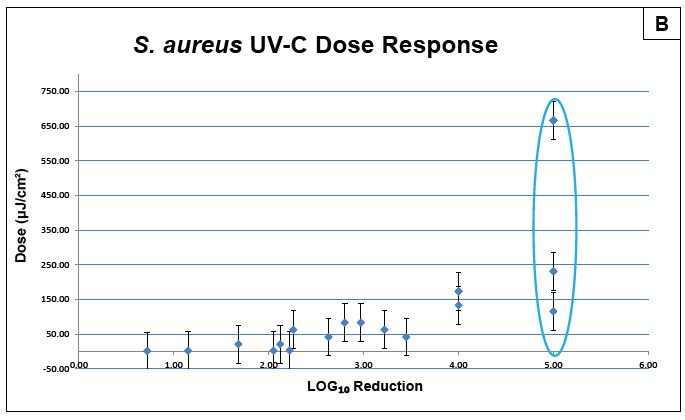Presented at the International Association of Food Protection
Introduction:
UV-C LED Irradiance vs. Current A Staphylococcus aureus contamination of food processing and contact surfaces is a source for food-borne infection for consumers of meat and meat products.
Purpose:
In this study surfaces contaminated with high loads of Staphylococcus aureus were exposed to 265nm and 275nm UV-C LED to assess the effects of multiple doses and irradiances.
Methods:
One inch square stainless steel targets inoculated with Staphylococcus aureus were exposed to a UV-C LED (265nm) array light source (Phoseon Technology) at 1.3, 1.5, 2.0, 2.5 and 3.0 mW/cm² (at the emitting window) from a distance of 15 mm. Doses (at the emitting window) ranged from 26 mJ/cm² through 150 mJ/cm² initially. Additional experiments extended the range of doses and included a second UV-C wavelength (275nm). UV-C lamp output was assessed to enable precise control of delivered dose. Surfaces were contaminated with 1.2 – 5.2 x 10⁶ cfu/target. After UV-C exposure, surviving bacteria were serially diluted, plated, and colony forming units (cfu) assessed. Log₁₀ reduction was calculated as the difference in the Log₁₀ of geometric means between the unexposed control and the exposed test samples. Each test sample included four independent exposures at each condition over a total of 30 UV-C LED irradiance and dosage conditions.
Results:
Irradiances of 1.3 and 1.5 mW/cm² (at the emitting window) resulted in 4-5 Log₁₀ reduction of Staphylococcus aureus CFU on exposed targets. This corresponded to doses of between 20 and 52 mJ/cm² (at the emitting window). Increasing the irradiance to 2, 2.5, and 3.0 mW/cm² (at the window) to deliver a dose of 150 mJ/cm² (667 μJ/cm² at the target) resulted in a 5 Log₁₀ reduction in all cases. Consistent 5 Log₁₀ reduction in S. aureus CFU was achieved in between 40 and 75 seconds.
Significance:
Short UV-C exposures (265nm or 275nm) of ≤60 seconds were sufficient to result in a 4 Log₁₀ reduction of Staphylococcus aureus. Treatment of food products by 265nm (or 275nm) UV-C LEDs represents a viable investigation path for decreasing food-borne Staphylococcus aureus infections in consumers.


